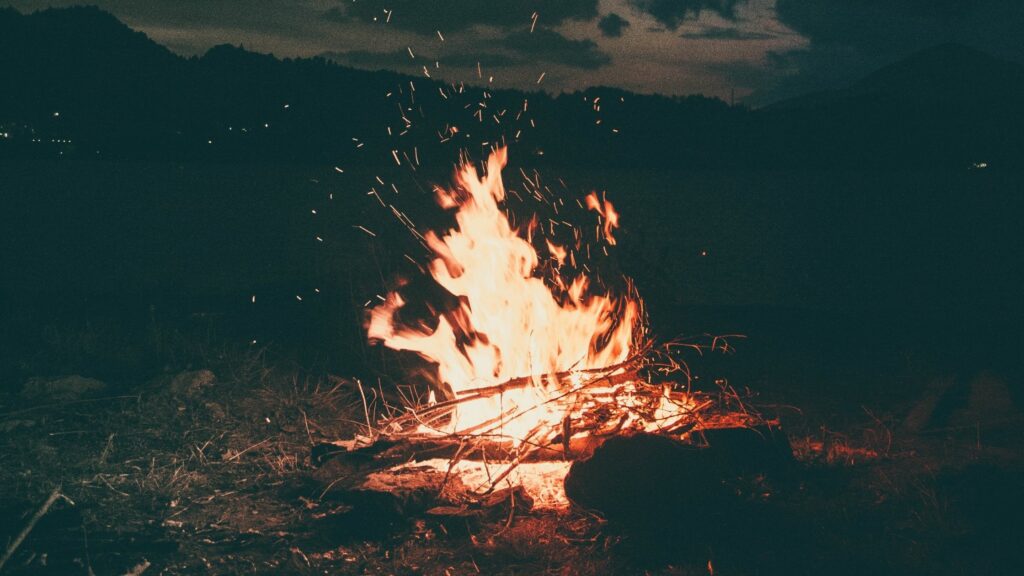I don’t know if it’s just from celebrating so many Catholic liturgies over my lifetime, but I can’t look at fire—or the light and shadow cast by the sun, or an eclipse, or the full moon, or the candle on my dinner table—without thinking of the fire we light at the Easter Vigil.
On the night they will be initiated into Christ, the elect first gather with all the faithful around a blazing fire outside the church under the dark of night. Is this simply cool liturgical “theater” or a dramatic prelude to the more important parts of the Easter Vigil? Or is there something deeper and essential in the lighting of that fire that reveals the meaning of baptism into Christ?
A new perception
Honing our vision to see the deeper meaning is a necessary stage in the Christian initiation process. During the Period of Postbaptismal Catechesis or Mystagogy, the neophytes are led by the faithful to “a fuller and more effective understanding of mysteries” through the Gospel and the sacraments they have celebrated. Out of the experience of these sacraments, the neophytes “derive a new perception of the faith, of the Church, and of the world” (RCIA 245 USA / 235 CAN). Mystagogy is the act of seeing the mystery of Christ embedded within the symbols and actions of our liturgies so that our participation in those liturgies reshapes us more and more to live as Christ in the world.
I like to call this new perception wearing “mystagoggles.” But attaining this new vision isn’t as automatic as putting on new glasses. Mystagogy needs “mystagogues” who help neophytes see with their hearts what their eyes are learning to focus on.
Mystagogy is the act of seeing the mystery of Christ embedded within the symbols and actions of our liturgies so that our participation in those liturgies reshapes us more and more to live as Christ in the world.
Questions mystagogues ask
Like everything in the initiation process, mystagogy is the work of the Spirit. But we can collaborate with the Spirit to help our neophytes sharpen their vision. We can do this by asking and reflecting on mystagogical questions with the neophytes.
Let’s use the fire and Paschal Candle at the Easter Vigil as an example. These are some questions that can help you and your neophytes see the ritual symbol of fire and light more deeply and broadly.
From the ritual actions: During the ritual, pay attention to what happens at the Easter Vigil around fire and light, darkness and night, flames and candles. After the ritual, recall what you saw.
- What do you see? How big is the fire? What do we do with the fire? What does the priest do with the Paschal Candle before it is lit? What symbols do you see on the Paschal Candles? How did you receive light for your candle? Inside the church, where is the Paschal Candle placed? What do we do with the Paschal Candle during the various parts of the Easter Vigil? After the baptism, who gives the newly baptized a lighted candle?
- Having noticed what happens in the ritual around fire and light, ask yourself why you think the ritual asks us to do that? In other words, what do you think the ritual means based on what you saw happen? For example, why do you think the ritual instructions for the Easter Vigil all say that the Vigil must take place at night, after nightfall?
From the ritual words: During the ritual, listen carefully to the words spoken or sung about fire, light, day, night, or darkness. After the ritual, recall some of these words, songs, or phrases. You might also look at the words of the readings, prayers, and blessings from the Lectionary, Roman Missal, or Rite of Christian Initiation of Adults.
- What did the priest or deacon or other liturgical ministers say or sing about fire or light? What songs or acclamations did the people sing that spoke of light? What readings from Scripture did you hear that night about light and dark, night and day?
- Look especially at the words of the Exsultet, which is the song sung by the deacon, priest, or music minister at the ambo shortly after the beginning of the Easter Vigil once everyone is in the church. You can find the words in the Roman Missal. This is a long proclamation of praise to the Father who throughout history has been present to us in our darkest moments. We praise the Father especially for giving us his Son Jesus, the “Morning Star who never sets” and is reflected in the light of the Paschal Candle. The entire structure of the proclamation parallels that of the Eucharistic Prayer. What do the words of the Exsultet say about light? What images strike you from the text?
- Look also at what the priest says to the newly-baptized as they receive from their godparent a candle lit from the Paschal Candle. Do those words have deeper meaning after reflecting on the Exsultet?
From nature, the cosmos, and our daily rituals: Look at the natural ways we encounter physical light and dark in our daily lives, our everyday rituals, and in the seasons.
- Think of your morning and evening routines. Is there anything there that reminds you of how our faith understands being “children of the Light”? Do you light birthday candles? What new meaning might that give to the baptismal candle you received at your baptism (and vice versa)?
- Notice the change of seasons and length of days and nights. How do the change in seasons add to your understanding of the words spoken as the Paschal Candle is prepared to be lit: “Christ yesterday and today, the Beginning and the End…All time belongs to him”?
- Notice that Easter is “scheduled” by the cosmos and the natural shifts of light and dark: Easter occurs on the first Sunday after the first full moon after the Spring equinox. How does that awareness give another layer of meaning to what we celebrate at the Easter Vigil?
From our feelings and emotions: Our feelings, especially at profound moments, are often signs of the Holy Spirit urging us to pay attention to the moment we are in.
- What emotions do you remember feeling during the Easter Vigil? What was happening in the ritual that sparked that emotion? What memories did that emotion call to mind? Does that emotion say something to you about what the Holy Spirit is doing in you or calling you to notice?
- When you think of “standing in the light” or “being in the dark,” what emotions surface in you? When in your life have you felt God’s presence in a moment of light? When have you felt God’s presence in a moment of darkness?
From our Catholic tradition: Connect your experience of the Easter Vigil fire and Paschal Candle to the other ways we use fire and light in our Catholic life.
- Think of as many Scripture passages that talk about light and dark, night and day, fire or candles. Do any of these passages give another layer of meaning to the Paschal Candle?
- Recall other ways we use light and candles in rites and devotions. For example, the Presentation of the Lord, the Advent wreath, lighting candles to remember a loved one or a special intention, dedication candles of a church. How are these practices connected to the fire and Paschal Candle of the Easter Vigil?
- Look at the hymns and songs you sing at church that speak of light and dark. Or at iconography, sacred art, statues, and even the architecture of your church building and how light and dark interact in the spaces you pray in. What new light do you see when you connect these to your experience of Christ the Light at the Easter Vigil?
Given all this information and reflection, ask yourself what it all means:
- What does it mean for us as Christians to say that Christ is the light of the world?
- What does it mean to say that we have been given the light of faith?
- What does it mean to be a child of the light?
- How can we keep the flame of faith alive in our hearts?
Make it personal
Finally, ask what does all this mean for me, personally as a member of the Christian community? What difference does all this make in the way I live my faith? What concrete actions am I being called to do for the people that I encounter in my daily life if I have been given the light of Christ from the day of my baptism? How can I help others encounter Christ in the dark moments of life, when it’s hard to see, when all we can do is wait for the sun to rise?
When you can see the deeper significance of the symbols of our rites in this mystagogical light, you will begin to see everything around you as a reflection of Christ the Light. And you yourself will grow more and more into a mirror that increases that life-giving light for others.
Your turn
What has mystagogy looked like for your parish in the past? How will it look this year? Share your thoughts in the comments below.















